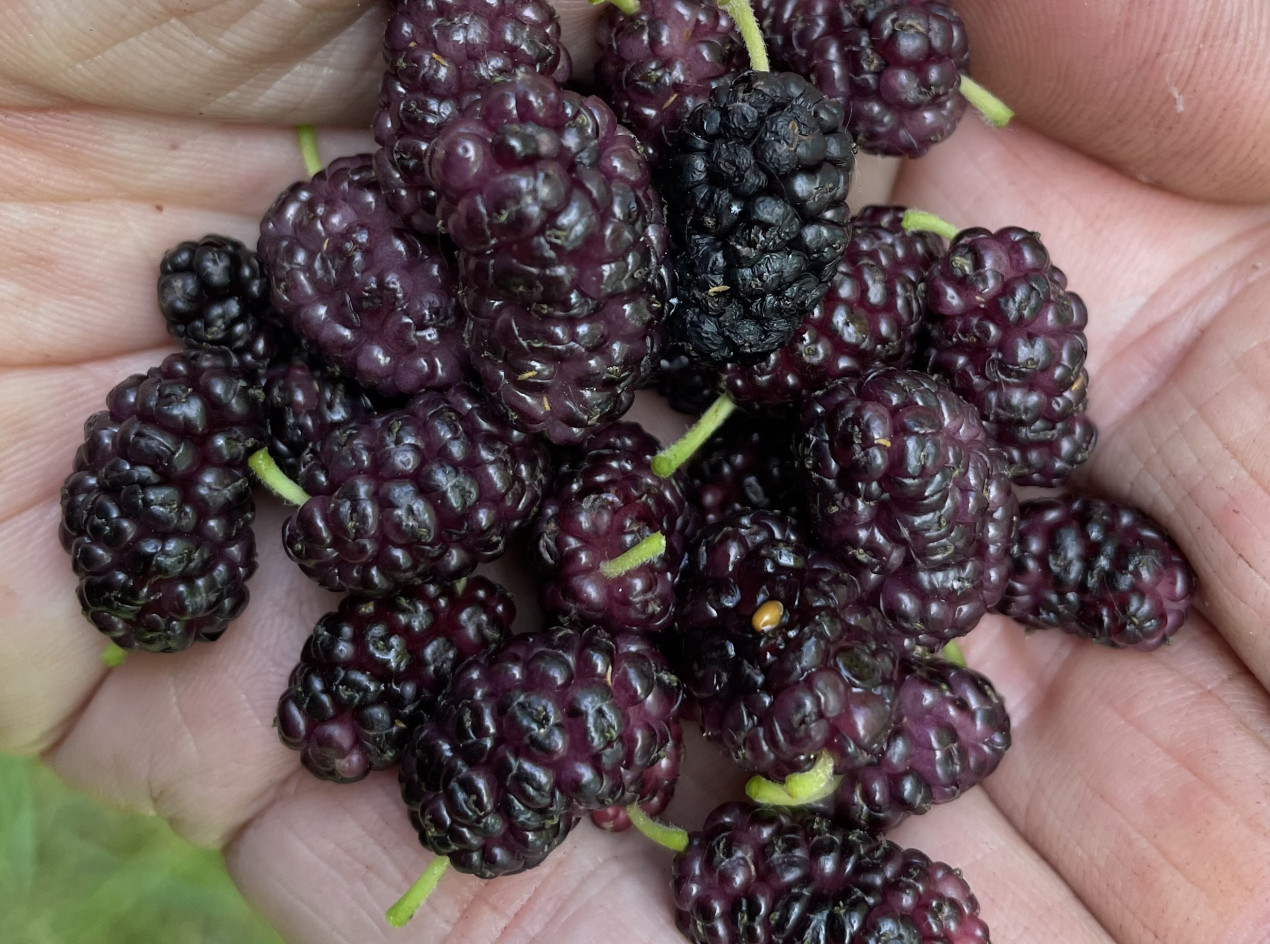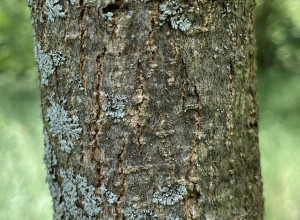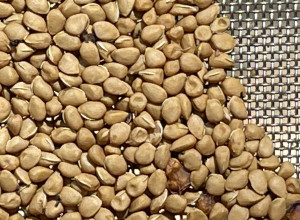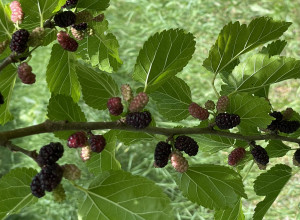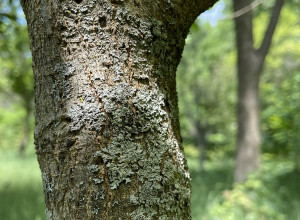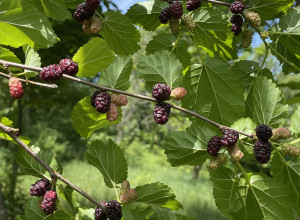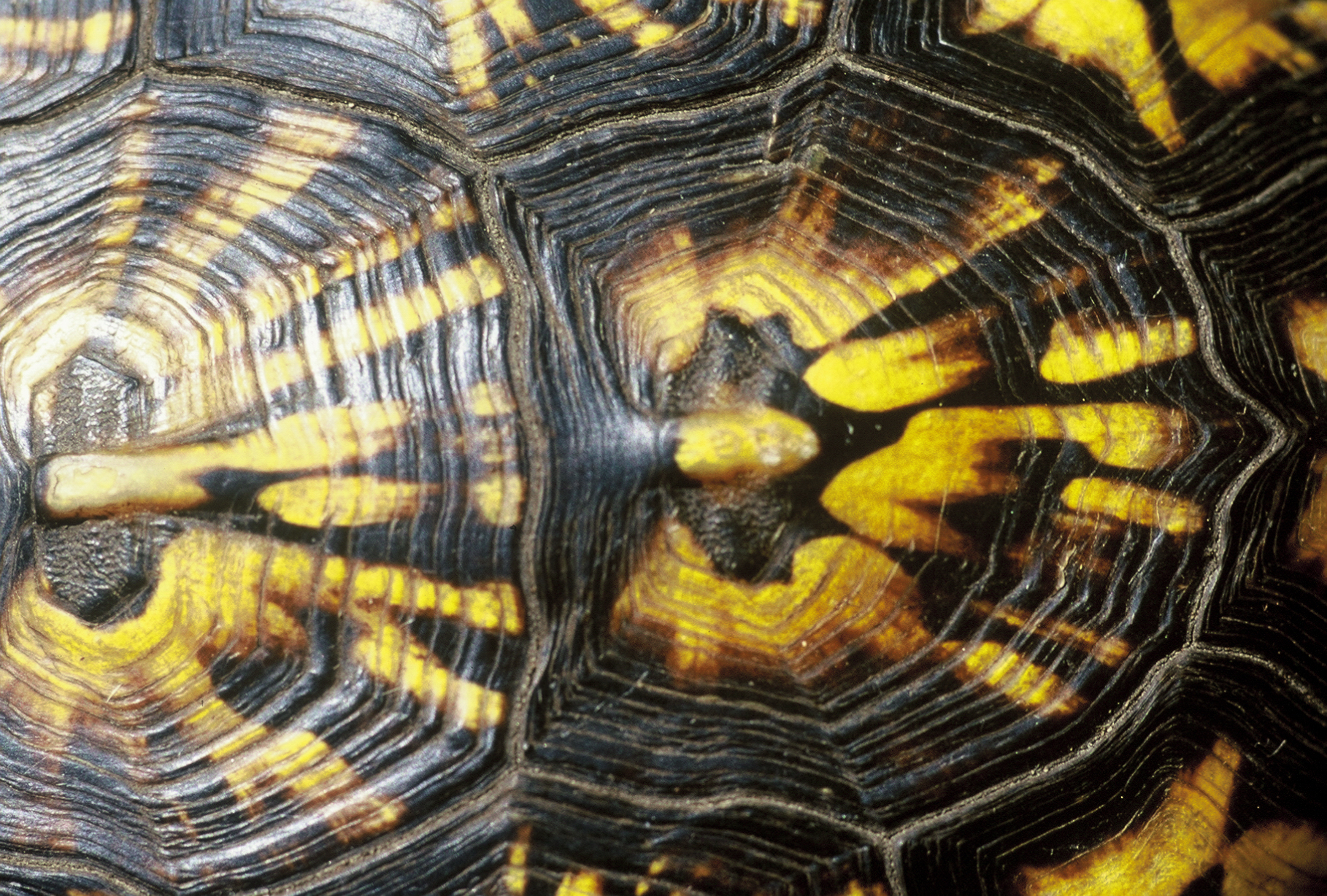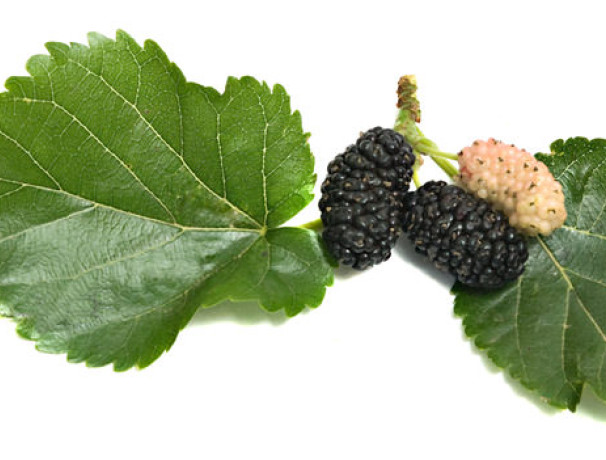Experience-Seeds-Knowledge-Plant Discoveries-Ecological Enrichment-Join Now Click Here!

North American Species-Excellent Flavor with a Nice Balance of Tart and Sweet
Many people worldwide enjoy the mulberry fruit both fresh and dried. Every country has its favorite. In the U.S. before the introduction of mulberries for silk, red mulberry was collected and used as a summer berry. The sweet and tart fruit was mostly known in the midwestern and southern U.S. Although found in some northern states it was found often near rivers and streams where the seeds could take hold of open soil which is required for its germination. Red Mulberry is the indigenous North American species of mulberry found from Texas to Illinois. The fruits from this species are less insipid than most with a bit of tartness and a less watery flavor compared to the common mulberries often encountered. But it does vary from tree to tree.
The seedlings I have grown were from wild collected seeds in its range when I had the nursery. The trees are considered non hybrid in origin although it took more than a few grow outs to winnow it down to what looked like the species. From those small groups I began to make selections based on hardiness and leaf structure. After planting out many I whittled it down to five trees of which only three survived Michigan's winters. One of the trees was very productive and has since fruited since 2017. The characteristics match all the criteria for Morus rubra. The fruits are one inch red ripening to violet fruits which ripen in mid-summer. Easy to grow in any soil. Vigorous growth averaging 3-5 ft. per year. Fruits in 4-5 years from seedling when they reach 6-8 ft. tall.
All plants of red mulberry are self fruitful. Having two plants is ideal for better fruit set as there may be some plants that are self infertile. So far all of our plants are productive at our farm with no infertile plants or male plants. Mulberries are polygameodioecious meaning male and female flowers are on the same plant and/or the plants do produce separate male flowers that pollinate the female fruiting flowers.
The full tree image in the picture you see was one I took while in Texas of a 'pure' red mulberry in the front yard of a housing development I was visiting. The developer actually saved the tree from the chainsaw. People do not like fruit trees dropping fruit on their nicely manicured lawn especially mulberry which is considered a weedy tree to begin with. Notice the dark bark which is kind of flakey and in strips. No other mulberry has bark like that. Young trees also have a unique bark feature often overlooked as a means to properly identify the tree. A good black and white image of red mulberry foliage can be seen in Agriculture Handbook 450 Seeds of Woody Plants Manual available as a pdf on line.
"Lavender Life" red mulberry trees offer a chance to further develop both cultivar level plants as well as a seedling orchards. A density of trees with overlapping flowering times would bring a certain stability to the species and would also demonstrate a new fruit under cultivations similar to the black mulberry. There are already two varieties of Red mulberry available from Texas. Those did not survive here. Also it may be likely that no selection is needed and the species itself is good enough to use commercially or home use. The trees are heavy fruiters of delicious fruit in zone 5. The trees themselves are very vigorous but need protection against deer as they love the foliage. For absolute certainty of identification with mulberries you need a genetic identification test. If you are afraid that this is a hybrid and not true, then this seed may not be 100 percent true and not useful for you.
"Lavender Life"
Heavy producing indigenous North American species. Large one inch violet turning dark purple fruit are produced ripening in mid June in southern Michigan. Parent tree has taken minus 25F. Selected from several populations of commercially grown native plant nurseries who went the extra mile to find non hybrid seeds. This selection provides both hardiness and yield to a long forgotten fruit tree. Seeds are produced isolated from other mulberry trees on our farm and grown in a cluster of non hybrid trees. This seed source provides both a hardy zone 5 seedling source as well as a source of good fruiting red mulberry seed source. Has good leaf retention with no apparent foliar diseases or spotting as well as vigor and an open wide spreading crown perfect for picking fruit and little pruning needed once past the browse line of deer. Further grow outs from the seeds will produce all fruitful trees as well as development of further cultivars from this species. The identity of this variety and the species it represents is being evaluated by genetic analysis and will be published here.
Scionwood is sent upon request and is dormant in the fall and winter. Otherwise only seeds are sent with this order unless requested.
To germinate the seeds: A brief cold and moist stratification of 60 days of 33 to 38F will aid in germination. The seeds are easy to grow so best to surface sow and keep moist and use a light sand to hold the seeds in place. Seeds normally all germinate quickly however the dormancy period unifies the germination period so they all pop at once. A favorite of slugs and grasshoppers, care is needed to prevent their demise.
Seeds are sent dormant and stored refrigerated since harvest and processing done at the end of June. Seeds are dried but not overly dried to prevent damage to the embryo. Scions are harvested dormant and should be stored cold when you get them. The scions are sent this way without their leaves as dormant scionwood in January and February
| Plant Specs | |
| Genus & Species | Morus rubra |
| Seed Source | Michigan |
| Hardiness | minus 25 F or slightly more |
| Height (ft) | 80 |
| Width (ft) | 30 |
| Pollination Requirements | Male and female flowers separate but on the same tree. Plant 2 for best fruit production but normally self fruitful. Will cross with other mulberries if flowering overlaps. |
| Soil | Super adaptable from rock to clay. |
| Climate | Does best in zones 5-9. |
| Ease of Cultivation | Very vigorous growing 4 ft. per year until fruiting. Anyone can grow this plant. Fruits once trees get to 5-6 ft. tall with a 2 inch caliper or so. The trees are naturally productive and have a nice tasting fruit. The fruit is distinct in structure and usually a red or reddish black color. Like other mulberries, leaves can be both lobed and unlobed on the same tree but normally unlobed leaves are predominant in this selection. |
Related Plants
Sweet Juice Black Mulberry Seeds and Scions
sold out Hardy and Vigorous Selection with Delicious Fruit-Not too Sweet and Not too Wa..
$220.00
